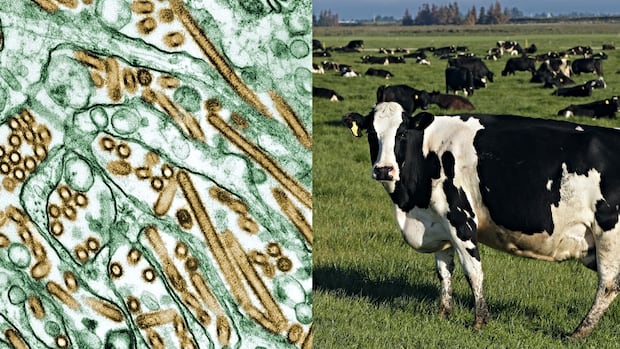California officials have declared a state of emergency over the spread of bird flu, where infections in dairy cows are increasing and causing sporadic illnesses in people in the U.S.
That raises new questions about the virus, which has spread for years in wild birds, commercial poultry and many mammal species.
The virus, also known as Type A H5N1, was detected for the first time in U.S. dairy cattle in March. Since then, bird flu has been confirmed in at least 866 herds in 16 states.
More than 60 people in eight states have been infected, with mostly mild illnesses, according to the U.S. Centers for Disease Control and Prevention (CDC). One person in Louisiana has been hospitalized with the first known severe illness caused by the virus, U.S. health officials said this week.
Here’s what you need to know.
Why did California declare a state of emergency?
Gov. Gavin Newsom said he declared the state of emergency to better position state staff and supplies to respond to the outbreak.
California has been looking for bird flu in large milk tanks during processing. And they have found the virus it at least 650 herds, representing about three-quarters of all affected U.S. dairy herds.
Dr. Maria Van Kerkhove, the World Health Organization’s director of epidemic and pandemic preparedness, is calling for increased surveillance globally of animal populations that are known to be susceptible to H5N1, including wild birds, poultry, swine and cattle.
The virus was recently detected in Southern California dairy farms after being found in the state’s Central Valley since August.
“This proclamation is a targeted action to ensure government agencies have the resources and flexibility they need to respond quickly to this outbreak,” Newsom said in a statement.
What’s the risk to the general public?
Officials with the CDC stressed again this week that the virus poses low risk to the general public.
Importantly, there are no reports of person-to-person transmission and no signs that the virus has changed to spread more easily among humans.
In general, flu experts agreed with that assessment, saying it’s too soon to tell what trajectory the outbreak could take.
“The entirely unsatisfactory answer is going to be: I don’t think we know yet,” said Richard Webby, an influenza expert at St. Jude Children’s Research Hospital in Michigan.
But virus experts are wary because flu viruses are constantly mutating and small genetic changes could alter the outlook.
Are cases becoming more serious?
This week, health officials confirmed the first known case of severe illness in the U.S. All previous U.S. cases — there have been about 60 — were generally mild.
The patient in Louisiana, who is older than 65 and had underlying medical problems, is in critical condition. Few details have been released, but officials said the person developed severe respiratory symptoms after exposure to a backyard flock of sick birds.
That makes it the first confirmed U.S. infection tied to backyard birds, the CDC said.
Tests showed the strain that caused the person’s illness is one found in wild birds, but not in cattle. Last month, health officials in Canada reported that a teen in B.C. was hospitalized with a severe case of bird flu, also with the virus strain found in wild birds.
Previous infections in the U.S. have been almost entirely in farm workers with direct exposure to infected dairy cattle or poultry. In two cases — and adult in Missouri and a child in California — health officials have not determined how they caught it.
Dr. Amesh Adaljia, a senior scholar at Johns Hopkins Center for Health Security and an infectious disease physician in Baltimore, said H5N1 doesn’t pose a threat to the general public at this time, but that doesn’t mean it should be completely ignored given exposures to farm workers.

“We’ve only really had one severe case in the United States and understanding why most cases are mild, that’s also a major challenge,” Adaljia said in an interview with CBC News.
The case in B.C. was a strain more related to what is circulating in geese, whereas the version in Louisiana was one more closely related to what’s circulating in poultry, Adaljia said.
How can people protect themselves?
People who have contact with dairy cows, commercial poultry or backyard birds are at higher risk and should use precautions including respiratory and eye protection and gloves, the CDC and other experts said.
“If birds are beginning to appear ill or die, they should very careful about how they handle those animals,” said Michael Osterholm, a public health disease expert at the University of Minnesota.
Day 67:19Why an infectious diseases expert says we should be paying close attention to H5N1
Dr. Samira Mubareka, an infectious diseases physician and microbiologist at Sunnybrook Research Institute in Toronto, says the case of a teenager in BC made critically ill from the H5N1 virus shows it’s time to pay closer attention to how bird flu is spreading and changing as it moves from birds to mammals.
The CDC has paid for flu shots to protect farm workers against seasonal flu — and against the risk that the workers could become infected with two flu types at the same time, potentially allowing the bird flu virus to mutate and become more dangerous. The U.S. government also said that farm workers who come in close contact with infected animals should be tested and offered antiviral drugs even if they show no symptoms.
Dr. Jesse Papenburg, a pediatric infectious disease specialist at the Montreal Children’s Hospital, said Canadians should be aware of the increased risk of exposure and transmission to humans through contact with poultry and wild waterfowl, other animals or their environments.
“Have a lot of situational awareness about influenza-like illness, especially as Canada moves into flu season along with the U.S.,” Adalja said.
How else is bird flu being spread?
In addition to direct contact with farm animals and wild birds, the H5N1 virus can be spread in raw milk. Pasteurized milk is safe to drink, because the heat treatment kills the virus, according to the U.S. Food and Drug Administration.
But high levels of the virus have been found in unpasteurized milk. And two brands of raw milk sold in stores in California were recalled in recent weeks after the virus was detected at farms and in the products.
In Los Angeles, county officials reported that two indoor cats that were fed the recalled raw milk died from bird flu infections. Officials were investigating additional reports of sick cats.
Health officials urge people to avoid drinking raw milk, which can spread a host of germs in addition to bird flu.
The U.S. Agriculture Department has stepped up testing of raw milk across the country to help detect and contain the outbreak. A federal order issued this month requires testing, which began this week in 13 states.



